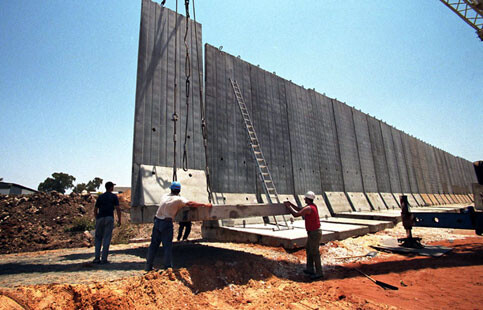The Electronic Intifada 28 March 2003

A Palestinian family sits in what used to be an alleyway between two rows of homes. Behind them, the facade of a home, behind that rubble in a “no man’s land” area stretching back to an Israeli wall. (Ronald de Hommel, 2002)
Such obligations were soon brushed aside in favour of endless adjustments, negotiations and delays. First President Bush agreed to postpone the road map’s publication until after Israel’s elections, then the deadline was the formation of an Israeli government. Now it is dependent on the new Palestinian prime minister, Abu Mazen, announcing his cabinet, or maybe it will have to wait until “after” the war in Iraq, whatever that might mean.
But surprisingly, one person now taking the road map seriously is the Israeli prime minister, Ariel Sharon. He has been panicked by the mounting public commitments Washington is making to the rest of the Quartet, the United Nations, European Union and Russia. Britain’s Tony Blair, who met Bush this week (Wednesday, March 26), has been calling in the US debt on the Middle East peace process that has accumulated over the war in Iraq.
Sharon is clearly fearful not only that he may eventually be forced to agree to the creation of a Palestinian state but that the judges of that process may not be Washington alone but the other members of the Quartet, all of whom Sharon believes are hostile to his country.
For months, Israeli officials have been furiously shuttling between Jerusalem and the White House lobbying to have the road-map torn up. A memo from Sharon’s office, published in the Israeli daily Haaretz two weeks ago, revealed that, along with more than 100 other alterations, Israel was urging the Americans to change the road map’s goal from creating an “independent” Palestinian state to one with “certain attributes of sovereignty.”
Palestinians fear that behind the scenes Sharon and Bush are holding up the road map while the Israeli prime minister establishes more irreversible facts on the ground. Large-scale settlement building for the moment is out: it too clearly betrays the map’s spirit.
Instead, Sharon is turning to his own advantage the 360km-long security wall being built around the West Bank to protect Israelis from Palestinian attacks.
Sharon is a very late convert to the virtues of the wall. When his former Labour coaliton partners cornered him into building it last summer, he reiterated that it would not become a “political” border — a code word among the right and the settlers for Israel’s refusal to demarcate the borders of a Palestinian state, particularly along the Green Line, the pre-1967 border with the West Bank.

An Israeli construction team lowers sections of Israel’s “Berlin” wall into place. (Ronald de Hommel, 2002)
But in recent days there has been a revolution in the thinking of Sharon and his settler allies: they now believe the barrier should become a border. It can be used to create the parameters of the Palestinian state demanded by the Quartet, but in the enfeebled form that has always been Sharon’s preferred vision of Palestinian statehood.
With Labour out of the government and his support drawn mainly from pro-settler parties, and with an Israeli public more interested in the achievement of separation than the details of its execution, Sharon now has a free hand to redraw the political map.
In the past fortnight he has announced two major changes to the wall’s path. One is a second barrier on the far side of the West Bank, through the Jordan Valley, that will join with the first wall to turn the West Bank into what Palestinian officials are not unreasonably calling “a giant prison.”
The second change is a decision to reroute the wall along the Green Line so that it makes huge detours into the West Bank to include the large settlements of Ariel, Kedumim and Immanuel. Israeli officials say there is a similar plan for the southern West Bank where settlement blocs have been built around Bethlehem and Hebron.
Neither of these “adjustments” will increase Israelis’ security — the official reason for the wall’s construction. The Jordan Valley poses no security threat to Israel, and the inclusion of tens of thousands more Palestinians on the “Israeli side” only undermines the wall’s protective role.
The object of these changes is to be found elsewhere, in the sweeping confiscation of swaths of land to build the barrier. A future Palestinian leader will be lucky to have 60 per cent of the West Bank for his state, parcelled up into unconnected cantons.
Sharon’s spokesman, Ra’anan Gissin, says the wall can always be taken down after a peace agreement. This ignores Sharon’s track record of creating facts on the ground — after all, it was he who initiated the huge settlement building programme in the West Bank in the late 1970s that is making a peace deal so intractable now.
Gissin’s glib statement also glosses over the enormous investment Israel is making in the wall — at least $2bn and counting. Quite a price for a “temporary” measure that offers Israelis so little security.
Jonathan Cook is Israel/Palestine correspondent for Al-Ahram Weekly, he wrote this analysis exclusively for the Electronic Intifada..



